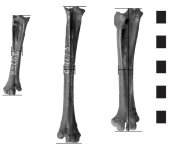albertonykus
Well-known member
Long, K.L., D.R. Prothero, and V.J.P. Syverson (2020)
How do small birds evolve in response to climate change? Data from the long‐term record at La Brea tar pits
Integrative Zoology (advance online publication)
doi: 10.1111/1749-4877.12426
https://onlinelibrary.wiley.com/doi/10.1111/1749-4877.12426
Biology textbooks describe the small changes in the beaks of the Galápagos finches as exemplars of how birds evolve in response to environmental changes. Yet recent studies of the abundant fossil birds at Rancho La Brea finds no evidence of evolutionary responses to the dramatic climate changes of the glacial‐interglacial cycle over the last 35,000 years: none of the large birds exhibit any change in body size or limb proportions, even during the last glacial maximum about 18,000–20,000 years ago, when the southern California chaparral was replaced by snowy coniferous forests. But these are all large birds with large ranges and broad habitat preferences, capable of living in many different environments. Perhaps the smaller birds at La Brea, which have smaller home ranges and narrower habitats, might respond to climate more like Galápagos finches. The only three common small birds at La Brea are the Western Meadowlark, the Yellow‐Billed Magpie, and the Raven. In this study, we demonstrate that these birds also show complete stasis over the last glacial‐interglacial cycle, with no statistically significant changes between dated pits. Recent research suggests that the small‐scale changes over short time scales seen in the Galápagos finches are merely fluctuations around a stable morphology, and rarely lead to long‐term accumulation of changes or speciation. Instead, the prevalence of stasis supports the view that long‐term directional changes in morphology are quite rare. While directional changes in morphology occur frequently over short (<1ka) timescales, in the long term such changes only rarely remain stable for long enough to appear in the fossil record.
How do small birds evolve in response to climate change? Data from the long‐term record at La Brea tar pits
Integrative Zoology (advance online publication)
doi: 10.1111/1749-4877.12426
https://onlinelibrary.wiley.com/doi/10.1111/1749-4877.12426
Biology textbooks describe the small changes in the beaks of the Galápagos finches as exemplars of how birds evolve in response to environmental changes. Yet recent studies of the abundant fossil birds at Rancho La Brea finds no evidence of evolutionary responses to the dramatic climate changes of the glacial‐interglacial cycle over the last 35,000 years: none of the large birds exhibit any change in body size or limb proportions, even during the last glacial maximum about 18,000–20,000 years ago, when the southern California chaparral was replaced by snowy coniferous forests. But these are all large birds with large ranges and broad habitat preferences, capable of living in many different environments. Perhaps the smaller birds at La Brea, which have smaller home ranges and narrower habitats, might respond to climate more like Galápagos finches. The only three common small birds at La Brea are the Western Meadowlark, the Yellow‐Billed Magpie, and the Raven. In this study, we demonstrate that these birds also show complete stasis over the last glacial‐interglacial cycle, with no statistically significant changes between dated pits. Recent research suggests that the small‐scale changes over short time scales seen in the Galápagos finches are merely fluctuations around a stable morphology, and rarely lead to long‐term accumulation of changes or speciation. Instead, the prevalence of stasis supports the view that long‐term directional changes in morphology are quite rare. While directional changes in morphology occur frequently over short (<1ka) timescales, in the long term such changes only rarely remain stable for long enough to appear in the fossil record.





